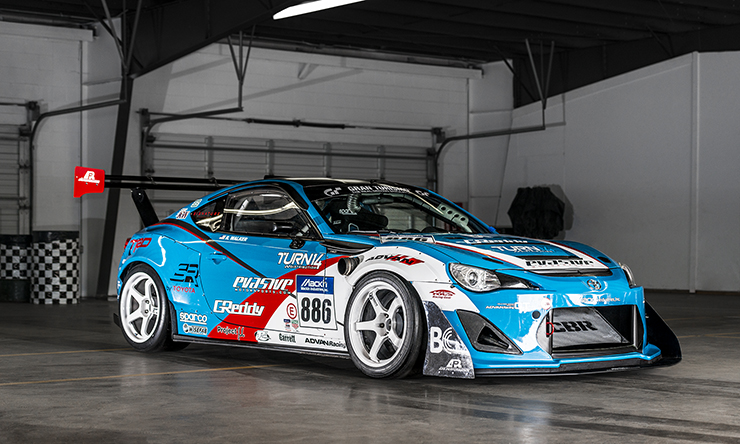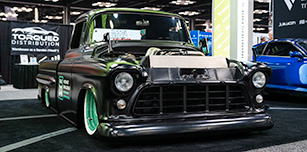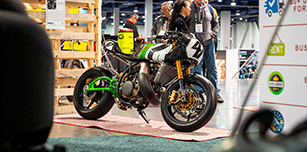Photos: Scott Tsuneishi, Mackin Industries, Evasive Motorsports, Kyle Crawford, and Randy Ly

The Pikes Peak International Hill Climb is one of the world’s most-famous hill climbs, and the second-oldest motorsports race in America. Dubbed the “Race to the Clouds” this year, the event celebrates its 100th anniversary in 2016. The race is run on a 12.42-mile long, fully paved course with 156 turns. It begins at 9,390 feet and finishes at the 14,110-foot summit of America’s Mountain. Located 15 minutes west of Colorado Springs, the first recorded hill climb was documented in 1901 when two Denver men challenged the mountain in a two-cylinder Locomobile Steamer. That climb took just over nine hours, but more importantly, drew recognition to an event that pushed the limits of man versus Mother Nature.
Drivers will say it’s the adrenaline rush they get every time they test fate, while others want to be a part of hill climb history. Regardless of the reasons, we respect and commend the men and women who challenge Pikes Peak and do so knowing one wrong turn can spell life-altering disaster.
Team Mackin and Evasive Motorsports are both no stranger to the Pikes Peak International Hill Climb (PPIHC) scene. This year marks the second straight year the Mackin 86 will be competing and the fourth consecutive year for Evasive Motorsports. As many of you many know, Front Street is owned by Turn 14 Distribution, and as Turn 14 Distribution is one of the main sponsors of the Mackin Industries Toyota 86, our Front Street team had a unique opportunity to go behind the scenes to see what goes into a year of preparation for the Pikes Peak event. The 86 has undergone numerous changes since 2015, when the machine was running its original FA20 engine and outfitted with minimal aero modifications. The team was faced with a new challenge to rebuild their Pikes Peak Toyota 86 with more aerodynamics, power, and handling than ever before.


This 86 has radically evolved over the last year into one of the most anticipated vehicles to return to the time attack class for 2016. We were lucky enough to be invited into the shop over the course of the build to learn the details as seen through the eyes of the fabricators, aero specialist, and driver, as the team prepared for the 94th running of the Pikes Peak International Hill Climb. The personal diary of the crew and driver is filled with many of the highlights as well as disappointments that make the world of motorsports what it is today. Nothing is as easy as it seems.
Mackin Toyota 86 Driver: Rob Walker
“My rookie year in 2013 was the toughest, as I had to learn everything from driving style to road conditions when attacking Pikes Peak. It was also the most memorable as it was the year that Sebastian Loeb broke the overall course record in the RedBull-sponsored Peugeot 208 T16. Watching the Peugeot 208 T16 take off from the starting line was a sight to see. We broke into the 11 minutes barrier our first year out with the Evasive FRS, but left a lot of time on the table as well. Overall, the team felt that we accomplished what we set out to do our rookie year, which was to finish the course in a respectable time.”


“Pikes Peak is different from a typical road race event such as Super Lap Battle in many ways. The fact that you only get to run it once a year and how the weather changes from one minute to another is unique to this treacherous mountain. I’ve been hailed on twice in the past three years towards the top of the summit when the weather was perfectly sunny at the base. On a road course, drivers have the luxury of warming up and gradually probing the limit of the car. Lapping the same road a few times allows the driver to find consistency and limit of the car. At Pikes Peak, you only get one chance to get each of the 156 corners right. A mistake will cost you seconds which is a lot of pressure for the team.”

“Last year’s Mackin 86 was more of an extension of a tuner car, which anyone can build from various parts offered in a parts catalog. The motor was still based on the FA20 block, with the addition of the Greddy turbocharger, and mated to a Nissan 350z transmission using a special adapter. Prior to Pikes Peak, we ran the car in ’14 at the GTA event in Road Atlanta. It was entered in the street class category so the modification was fairly basic, then built up to compete in Pikes Peak in 2015. It went from a street class time attack car to a full blown Pikes Peak competitor in less than a year.”
“Last year, we were disappointed with the results of our car but at the same time we were optimistic. The car was on pace to best our previous record but unfortunately, we lost the motor halfway through the run. PPIHC is divided into 4 sectors. We ran a great sector 1 and 2, times which consist of mostly mid to high speed corners. The motor was healthy up to the end of sector 2. Shortly after passing sector 3 at Glen Cove, the engine started to misfire and struggled. I knew the race was over for us once the smoke poured out of the rear. The only thing I could do was pull over to a safe spot, away from the record line.”

“Up to that point, I actually enjoyed last year’s drive with the Mackin FRS. It had the perfect balance between power and handling. It lacked downforce when compared to the Evasive FRS, but it made it up by having the torque from the turbo. The Mackin FRS also had a very advanced traction control system, which created enough yaw to rotate the car while putting down the power to the pavement for traction. The data showed that the supercharged Evasive FRS had lower top speed the previous year but was quicker though the corners. Overall, the Mackin FRS was actually quicker though the first sector and would have gained more time over the third sector with the steepest elevation changes.”

“Following the race, we knew our focus for the 2016 season was reliability and refinement. Building a competitive car requires plenty of time and patience, and we were willing to spend those long hours to make it a reality. Last year’s Mackin FRS was more of a tuner Time Attack car. Overall, my impression of this year’s build is more focused with one goal in mind, to break the 10 minute barrier at Pikes Peak. The amount of time the team dedicated to this car during the off-season has been astounding. I look forward to our return and challenging the climb with Mackin’s Toyota 86 V2.0,” sums up Walker.

Engine Upgrade
Mackin and Evasive Motorsports made numerous changes going into this year’s PPIHC, starting with a new 2JZGTE powerplant built by Evasive Motorsports technician and engine specialist JJ Reinholdt. The team had many engine options to choose from, but the 2JZ is race-proven and reliable. Luckily, the team had an engine they were able to pluck from their SEMA 2013 Lexus IS250 build.
The long-block was sent to DSport for machining while the rest of the team proceeded to work around the clock, upgrading and fabricating parts for their Pikes Peak machine. After months of careful consideration, the team developed an reputable engine package starting with a BC forged 94mm crankshaft connected to a set of Carrillo forged rods, Titan Motorsports Billet Main caps, ARP 625+ head studs, ARP main studs, HKS 1.2mm head gaskets, a Greddy intake manifold and JE Forged Asymmetric 11.0:1-compression pistons. The engine was punched out from the factory displacement to 3.4-liters; which provides the added benefit of offering improved turbo response with minimal lag while delivering a broad power band. These characteristics prove crucial when battling the altitude in Colorado.


DSport reworked the cylinder head by outfitting it with a set of GSC Power S2 cams, BC adjustable cam gears, GSC Power 1 mm-larger intake and exhaust valves, along with new GSC Power valve springs, titanium retainers, and Viton valve seals. Reinholdt modified the 2J oil pan and oil pickup, which is considered crucial to the engine’s success. Before the pan was installed, an Aristo VVTi oil baffle, oil pickup and custom trap doors were installed to minimize starvation and unwanted sloshing of oil when encountering high lateral G- forces through the tight corners of Pikes Peak. Gary Castillo of DesignCraft Fabrication also played an integral role by custom-designing an alternator relocation kit for the new engine.
Working with a tight deadline, the entire Evasive/Mackin crew took on numerous tasks including fabrication duties.
“Power is good, but make sure the engine has good throttle response and minimal lag,” was the directive Rob Walker hammered home to the crew when it came time to selecting the perfect turbocharger. A Garrett GTX4294R T4 Turbo with a 1.01 A/R exhaust housing was mated to an ETS Twinscroll T4 turbo manifold. Dual Turbosmart WG50 wastegates regulate boost pressure with the aid of a Turbosmart boost controller and evacuate though a set of Greddy custom wastegate dump tubes. Spent gases are expelled via a Greddy custom 4-inch race downpipe exhaust exiting out the passenger fender. A Greddy V-mount intercooler and aluminum radiator were installed while a Davies Craig EWP150 electric water pump delivers a consistent flow of coolant throughout the engine. Evasive Motorsport technician and aero specialist Kelvin Yong plumbed a custom water-cooling sprayer to the Greddy rear differential cooler, intercooler, Project Mu monoblock front 4-piston calipers, radiator and Koyo oil cooler to keep temps in check.
The fuel system is an intricate part of this build that Mackin employee and lead project manager Philip Chase spent plenty of time and effort to develop properly. For those who don’t know Philip, he likes to over-analyze and over-engineer parts or areas of cars which fellow enthusiasts might find trivial – in this particular case, the 86’s newly upgraded fuel system.
His expertise led him to make the decision to outfit the 86 with a deadhead fuel setup. A deadhead setup mounts the fuel pressure regulator near the fuel tank to avoid running a long return line; this reduces the amount of heat that the fuel is exposed to, which in turn eliminates any chance of vapor lock. A composite Radium fuel rail was plumbed with feed lines on both ends of the rail to ensure the Injector Dynamics 2000cc injectors have adequate fuel at all times. Successfully tested during the previous year’s PPHIC event, a pair of Holley HydraMat 11×11-inch and 15×8-inch fuel pickups were used in an ATL 12 gallon fuel cell. As extra insurance, a Radium Fuel Surge Tank plumbed with dual Bosch 044 fuel pumps feed off an AEM E85 high flow fuel pump. Motul fluids are used exclusively; 300V Competition 15W50 oil is used in the engine, with 75W140 Gear Competition used to lubricate the OS Giken limited-slip differential.
Motorsports Electronics
Former Evasive Motorsport tech and electronics specialist Edward Liu worked various areas of the cockpit of beginning with the installation of a Sparco PRO-ADV bucket seat and VAC Motorsports mount brackets. Liu rewired the entire interior including the power distribution modules and MoTec M130 ECU, and also fabricated a mount for the MoTec C165 dash display.
A Sparco steering wheel and 6-point HANS-compatible seat harness were also mounted into place. DesignCraft Fabrication was commissioned to customize the rear bulk head panel.

Nate Tasukon of Forward Motion Technologies was added to the team for 2016 with the responsibility of handling all of the tuning duties. Tasukon spent countless hours calibrating the engine to extract the highest level of safe horsepower, with an emphasis on longevity throughout the event. The car was able to spin the dyno rollers to the tune of 774 horsepower at a conservative 22.8 psi of boost pressure, although it encountered wheel spin from 7,000 rpm to 8,000 rpm. It’s noteworthy to mention that last year’s FA20 turbo setup made 478 horsepower – the power is definitely there with the new combination.
Body/Aero Upgrades: Kelvin Yong
“Our primary focus was to increase the overall aero performance on the 86 for the 2016 event. With last year’s car, we had a really short amount of time to prep the car for Pikes Peak – for the most part we ran the same aero kit we ran at Super Lap Battle the year before, which was a small splitter and Voltex wing. We added some bigger end plate to the front splitter prior to our climb to promote more downforce, and added a rear diffuser. That combination worked well, but in reality added minimal downforce.”
“Compare that with the Evasive FRS we ran in 2014, which focused 80 percent on aero modifications. Rob mentioned that towards the top of the mountain, the roads are very uneven with a lot of undulation. Fellow competitors have commented that when a car hits those rough patches, their cars would feel unsettled. The Evasive FRS easily tackled those areas as it maintained traction throughout the course and stuck to the road. In comparison, Rob mentioned the Mackin 86 with its simple aero package felt unsettled. For this year’s Mackin 86, we applied many of the aero modifications we had previously upgraded on our Evasive FRS such as the flat bottom.”

“We went with the biggest pieces APR had to offer including the front splitter, added a large APR GT1000 dual element rear wing, and a rear diffuser taken from a Dodge Viper. Currently, we are running a bigger rear wing which is chassis-mounted, as opposed to the previous year’s splitter setup which was sunken in more and molded into the Rocket Bunny kit – it was set up more for cosmetics. This year we extended the APR carbon honeycomb diffuser outwards two more inches in comparison to last year, along with the bigger end plates, then we changed the angle to promote more downforce and chassis-mounted it instead of simply being bolted to the bumper.

The entire undercarriage has been flat-bottomed using ARP carbon honeycomb. The idea of having better flow on the bottom of the car is to create two separate pressure zones. Ideally, if you want to have more downforce without raising the coefficient of drag, you can design the car to work like an upside down air foil (airplane wing). When you have the air hitting the top of the car, the air is flowing slower over the top than it is over the bottom; naturally the air from the top wants to equalize the bottom (lower or negative pressure), then it squeezes the car down into the ground.


We ran into some engine bay cooling issues the previous year, so for the 2016 event we added additional vents to the Seibon dry carbon hood. We attribute a lot of the issues as having to do with the turbo layout on the FA20 engine. Additional aero parts we added include APR carbon fiber side skirts, wind reflector, Rocket Bunny custom front over fenders +30mm, TRD Fender Wing, TRD rear stabilizing cover, Seibon roof, doors, trunk, and Plastics 4 Performance Lexan side windows.

It’s interesting to see a lot of the cars that do well at Pikes focus more on high horsepower than aero. I think race cars should look good. It has to be functional but not to a point where it looks stupid. Our main expectation going into this year’s race is to break the 10 minute barrier. Our best time with the Evasive FRS was 10:36 minutes in 2014, so we’re looking to best that record. We’re coming into this year’s event with some really good tires, electronics and respectable horsepower to back it up, something we lacked the previous years so we’re looking forward to see what this car can do. If we had more build time we would want to increase more frontal downforce but perhaps that’s something we can work on for next year.”
Shakedown Testing
Editor’s Note:
T-minus 3 days: the team managed to squeeze in a final test and tune session at Buttonwillow Raceway. The Toyota 86 roared into the paddock just after completing its second run session of the day. The deafening roar of the engine came to an abrupt halt, and the team quickly went to work making the necessary adjustments and changes to the 86’s Whiteline front and rear swaybars and end links and KW 3-way Competition coilovers. The remaining crew focused on repairing a faulty power steering pump that was bleeding profusely onto the tarmac.
Walker quickly unsheathed his helmet to provide vehicle feedback with one quick statement. “This thing rips!” he said.
Philip Chase gave a quick grin before quickly returning to aid in troubleshooting the vehicle’s issues. Walker caught a breather while analyzing the track data from his run, as the team continued to work on the vehicle in preparation for the final test session of the day.

Shakedown Driving Impressions: Rob Walker
“This year’s setup is much more physically-demanding to drive. The 2J engine has a massive amount of torque from down low, and the acceleration is mind-bending. The combination of the Revolution 4.785:1 final drive and OS Giken 1.5-way differential makes it a challenge to keep the power planted while shifting though the clutchless sequential Samsonas six-speed sequential gearbox. New for this year is the Wisefab Grip Kit to retain the optimal suspension geometry. We are also running slick tires for the first time this year. The car now requires increased steering effort due to the increase in grip level. The brake system is also a non-assisted unit this year. They provide greater pedal feel, but require more pedal pressure and effort. Overall, the car requires both physical and mental concentration to keep it on the road.”

“The undulations and overlapping of pavement from one material to another; some sections have a runoff which is paved and some do not. All these small details change every year, especially the top section where it fights against harsh winter which wears down the road. The driving conditions are unforgiving and requires you to adjust your driving style. I feel very fortunate and lucky to be able to participate in such a historic event. Honestly, driving up Pikes Peak is an easy job compared to the effort put in by the team to prepare the car for this event. This year, we are running against various factory-built race cars in our division. It’s the diversity that makes this race more interesting.”


The Final Word: Rob Walker
It’s with a heavy heart we have to report that although the car was wicked fast, Pikes Peak got us again. The car suffered axle-related issues, and we were forced to retire with 4 corners left to the finish line. With the addition of the new engine and transmission, we consider the car a new build which suffered some teething issues during our practice sessions during the first two days. The crew worked hard to fix and resolve these issues but it also prevented us from going full speed through the lower sectors from the Start Line to switchback (S/B) below Glen Gove during our qualifying session. The event was incredibly tough on the car and the crew due to the altitude and the week-long 5:30AM practice schedule. We were able to resolve these issues and ran at full speed on the last two practice days.
Although we did not qualify as well as we wanted, the weather was sunny and dry when it was our time to race up the mountain. From my experience, cars that start later in the afternoon will risk having rain or worse yet, hail on the hill climb.
We prepared the car and waited for our turn to grid the car on the starting line at noon. Cars were released onto the course every 3 minutes until it was finally our time to run at 12:15PM. Ten seconds before the starting time, I turned on the water sprayer for the oil and radiator coolers and launched the car off the starting line. The car felt strong and we posted competitive sector times on the bottom section. I struggled to put the power down and experienced traction issues in the middle section but we were still in the fight for a podium finish in the class. We cleared both the bottom and top sections as we approached the end of the course when there was a sudden loud noise and the car lost its ability to move forward. It was hard to imagine there was only 4 corners left from the finish line and the race was over for us. I parked the car off the road in a safe location and radioed in to the crew with the news.
I am incredibly proud of the entire team who managed this difficult build and fought though technical issues we encountered throughout the week. We fought hard and made it to the race day as well as managed to post some competitive sector times with the initial chance to fight for a podium finish. We just can’t seem to get a break as we’ve experienced failure in the past two years from components that we typically do not expect to see, but that’s just a part of racing. I am heartbroken but at the same time blessed and honored to have worked with so many of my hard-working colleagues and sponsors. Thank you everyone! And never give up!


















